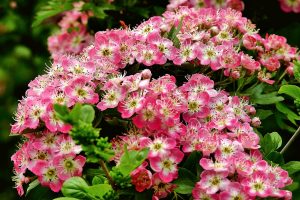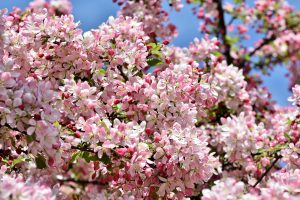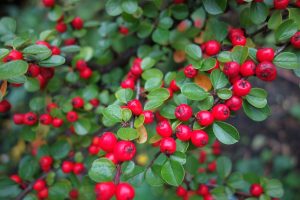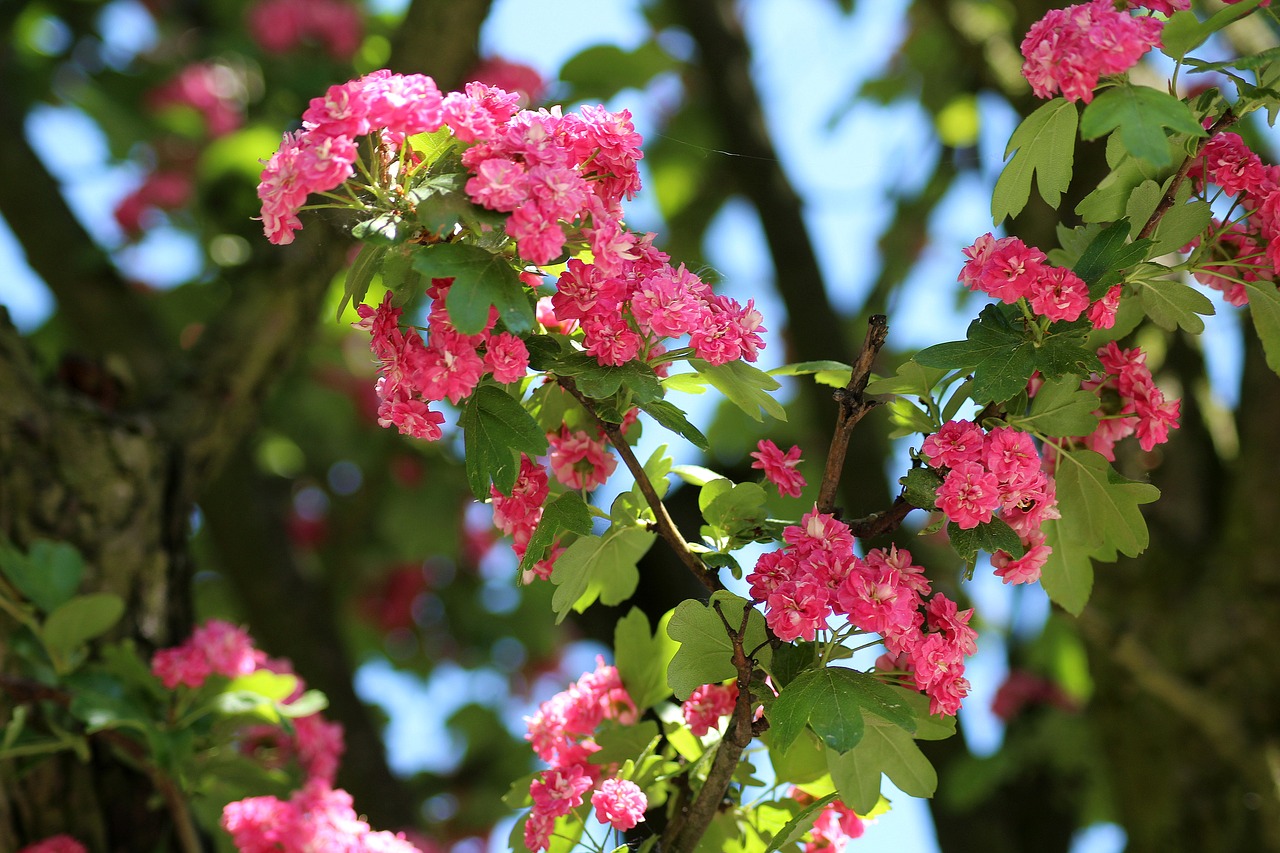Last Updated on April 10, 2024 by Real Men Sow
You will need something to screen your neighbors and create a stunning backdrop if you own a large property. You can make privacy screens or hedges with shrubs and trees in many ways. There are great trees for screening that can be used to create privacy in larger gardens, especially if they have dense or spiky foliage.
Are Small Trees Good For Screening?
There are small trees that can offer amazing visual displays and come in a variety of colours, beyond the usual assortment of greens found with Hedges. These are the top screening trees. You can pick one to create a monochromatic design or you can mix and match to add some flair to your home.
10 Trees For Screening You Can Grow In Your Garden
 Crataegus Pauls Scarlet (Hawthorn tree)
Crataegus Pauls Scarlet (Hawthorn tree)
The Hawthorn tree, a broadleaf deciduous tree that grows between 4-6 meters in height, is a broadleaf tree. The thorns can grow up to 2.5 cm in length and cover each branch. The leaves offer a wide range of options. They can be simple, glossy, with four lobes, and serrated with different sizes. The entire tree becomes covered with scarlet flowers, which are beautiful and small.
Although it can be cultivated very well as a hedge, we recommend that you keep it as a tree and cut off the flowering branches when planting as a hedge. The flowers and leaves create a stunning backdrop for your garden. However, the thorns will make it difficult for animals or people to pass through if they are planted as a hedge. Some fruits will attract birds and other animals to your yard, which is just the cherry on top.
Magnolia grandiflora
This hardy, showy tree spreads very well and can reach heights up to 8 meters. If not properly pruned, it will spread to new heights. It is best to plant magnolia it in an area that can accommodate a large tree. The stunning white flowers bloom between May and June.
Magnolia Grandiflora can thrive in full sun or partial shade but prefers a more protected area. This is a very fragrant, showy flowering tree and it also emits a lot of winter interest because it is one of the few evergreen trees. It is also tolerant to air pollution, making it an ideal tree for planting along roadsides or as a privacy screen for your property’s outline.
They’re known for their dark green leaves and very fragrant flowers, which are absolutely breathtaking. The crown is rounded and the white flowers become cone-shaped clusters. These eventually turn into fruit. This tree is an excellent choice for screening all year.
Betula Utilis Jacquemontii (Silver birch)
Birch trees have been awarded for their crisp, white bark. The Silver Birch is even more famous for its ability to wrap around the trunk and start peeling off the lighter orange colours below. Because the leaves start with rich green, they eventually turn to vibrant yellow and then fall off. This plant is a great example of contrast. It will be a delight to see your silver birch at any time of the year.
Small brown flowers will appear in large catkins, which are about 15cm tall. Once established, the tree can grow to between 9 and 15m tall. It can also reach 10m across near its top crown. However, it will only last 15 – 20years. It is medium-sized deciduous and grows quickly. The crown is oval with ascending branches. This tree makes a beautiful specimen piece regardless of the season. It can also be combined with other trees from this list to provide privacy in the spring. This tree can grow in any soil, as long as it is well-drained. It doesn’t need to be pruned, but you can trim the tree when it is dormant to adjust its size and shape. It requires very little maintenance and is extremely low-maintenance.
 Malus Profusion (Crab apples)
Malus Profusion (Crab apples)
The abundance of sweet, rich fruits in crab apples has made them a popular tree. The upright deciduous tree is tall and spreads out as it grows. This eventually results in a large number of flowers that are well-known. They begin as redbuds, then they open into rose pink flowers in small clusters at the beginning of spring. They eventually produce tiny blood-red fruits, measuring approximately 1.5 cm by Autumn. This adds an extra impressive feature. These flowers can be harvested and used for jams and jellies. The local birds will love to eat the fruits and stay all winter, so you’ll need to battle them.
You don’t have to be excited about the foliage. It starts as a reddish-purple color in springtime, but as the growing season begins, it becomes a bronze shade and eventually turns to amber, orange and red tones in autumn. People enjoy crab apples for their ability to pick the fruits, but also because they provide food for wildlife all year. This tree is also disease-resistant, so it requires very little maintenance.
Phyllostachys Nigra (Black Bamboo)
The black bamboo is an exotic type of bamboo and will add an Asian touch to your garden. It grows very quickly and produces straight stems like other bamboo. The bamboo’s upright stems will turn black in the second year of growth. This is a striking contrast to the green leaves. It spreads quickly using underground runners and can become quite invasive if it isn’t controlled. Its rapid spreading growth makes it an economical way to create privacy screens.
You only need to plant a few bamboo plants, and your privacy screen or hedge will naturally thicken over time. It will be difficult for animals or other creatures to squeeze between the upright stems. Black bamboo can be grown in partial to full sunlight and requires regular watering to keep the soil moist. If left unpruned, this evergreen bamboo will grow thick clumps that can reach up to 3-4 metres in height. Containers are also a great option for black bamboo.
Hornbeam Tree (Carpinus Betulus)
The common hornbeam tree can reach heights between 10-12 meters and spreads between 7-10 metres. This tree is larger than the average hornbeam tree, but it provides privacy and shade. The tree will bloom in March, depending on which male or female variety it is.
It is easy to grow this tree if you have good soil and can thrive in either full sun or partial shadow. Remember that it will need some pruning as it grows into a tree. However, if you are using it as a privacy screen, you can do some hard pruning and it will grow back with incredible porosity.
The tree is medium-sized and deciduous. It can either have an oval-shaped, rounded crown or a square-shaped pyramidal crown. The leaves are dark green and have sharp teeth. The leaves can grow up to 12 cm in length. This characteristic is attractive because it’s not susceptible to most foliar diseases. The dark green leaves will turn yellow or orange after you’re done. As mentioned, the springtime brings forth the appearance of flowering catkins. Small fruits appear in the summer.
Acer Platanoides ‘Crimson Sentry’
Crimson Sentry, an upright tree, is a good choice for residential gardens. This is the ideal tree for you if you are looking to plant a small tree. This tree is prone to dents in its branch structures. Although the canopy is quite compact, you’ll see leaves inside that range from deep purple to maroon to finally bronze.
For the first year, it needs full sun and regular watering. It will reach heights of 6 meters and widths up to 3 meters. The arrow shape makes it great for small spaces in your garden.
 Cotoneaster Cornubia
Cotoneaster Cornubia
This can be found in either a deciduous tree or an evergreen one. It is semi-evergreen, depending on where it is located. The leaves are very simple and there are clusters of pink or white flowers. These flowers appear in spring and produce stunning red, purple, or black berries by the summer. This will add variety to your garden’s colour palette. Semi-evergreen leaves are very bushy. They can grow to a height of up to 8 m and spread out to 8 m. However, you can control their growth and spread by keeping them at 4 meter height.
It thrives in dry conditions with well-drained soil, full sun exposure and good drainage. Once established, it is drought-resistant and requires minimal maintenance. This makes it ideal for slopes and along the banks of your garden. It can thrive in any soil, whether it is acidic, neutral, clay, chalky, sand or loam based. While the berries will attract birds to your garden, the tree’s thickness will protect them from prying eyes and larger visitors. Although this is a larger bush than a tree, it makes a great screen and provides all-year interest.
Eucalyptus Gunnii (Cider Gum)
This evergreen tree, also known as the cider gum, is one of the fastest-growing eucalyptus trees. It has a cone-shaped shape and dense canopy of leaves. Cinder Gum is smooth, flakes easily and can take on many colours, including brown, cream and pink. It emits a sweet scent. When it is younger, it will take on a silver-blue tone. As it gets older, it becomes a blue-green tone.
In summer, you will find clusters of white, small-sized flowers. These flowers, along with the foliage, make it an impressive specimen tree. It is fast-growing and can provide shade for your garden. It can grow to a height of 9 to 21 meters and a width of 5-12 meters at maturity. However, most specimens we have seen are not even close. The eucalyptus is deer-resistant, so any garden that might otherwise need a lot of fencing to keep the deer away can have it without problems.
Fagus Sylvatica Atropurpurea (Purple beech tree)
The deciduous tree produces dense, rounded crowns of dense leaves that form a pyramid-shaped shape. These leaves have an elliptical shape and a coppery hue that eventually turns deep purple. It can produce grey bark even in winter, which is stunning for any garden. However, its leaves will continue to turn coppery brown in spring when new leaves are growing. You will see the yellow-green flowers in the middle of spring, followed by the fall ripe fruits. This plant is ideal for hedges and screens, but can also be used in larger areas.
How Tall This Tree Grow For Screening
It will grow to 18 m tall and 12 m wide when mature and thrives in well-drained soil. The plant is not susceptible to serious diseases or insect problems, except for things like caterpillars or aphids. The maintenance requirements are minimal. The best thing about the purple Beech tree is its deer resistance. Anyone with deer on their property will be able to benefit from it.

